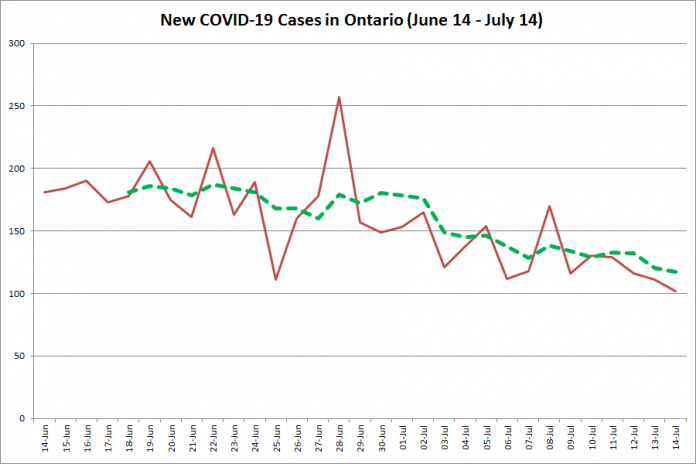In this week’s businessNOW™, we feature the Ontario government’s recent announcement of $1.4 million for Kawartha Lakes tourism industry, the findings of a Statistics Canada survey on the impacts of COVID-19 on businesses in Canada, Peterborough & the Kawarthas Economic Development’s 2020 Summer Company student start-ups, Peterborough’s business community supporting Peterburgers restaurant after a run of bad luck, and other local business news.
Upcoming business events include a virtual meeting on agri-food for restaurateurs in Northumberland County on July 16th, the National Angel Capital Organization and Innovation Cluster hosing three investor readiness webinars July 21st, 28th, and August 4th, the Workplace Safety and Insurance Board hosting a Health and Safety Excellence webinar on July 22nd, Venture13 and Northumberland CFDC hosting a webinar on using LinkedIn on July 23rd, the Workforce Development Board hosting a webinar on mental health and workplace well-being on July 30th, and Northumberland Community Legal Centre hosting a webinar on sexual harassment in the workplace on July 30th.
Ontario government announces $1.4 million for Kawartha Lakes tourism industry

The Kawartha Lakes region is going to receive a funding boost to help the area’s tourism industry recover from the COVID-19 pandemic.
Ontario’s tourism minister Lisa MacLeod was at Kawartha Coffee Company in Bobcaygeon last Thursday (July 9), along with infrastructure minister and Haliburton—Kawartha Lakes—Brock MPP Laurie Scott, to announce $1.4 million to support tourism-related initiatives in Kawartha Lakes.
“This funding is part of an effort to encourage homegrown tourism and talent,” MacLeod said. “As our government moves forward with reopening the province, we are proud to invest over $1.4 million to support initiatives in the Kawartha Lakes region that promote our communities and put our tourism industry on a path to recovery.”
The funding includes over $900,000 for City of Kawartha Lakes Tourism and $350,000 for Regional Tourism Organization 8 (RTO8) — the not-for-profit organization dedicated to promoting tourism in Kawartha Lakes, Peterborough and the Kawarthas, and Northumberland — for locally driven marketing programs.
“This provincial funding will help our businesses and residents who work in the tourism industry as we recover from the impacts of COVID-19.” Scott said. “The government is also investing over $150,000 in local festivals and events through the Celebrate Ontario program to help reinvigorate our province’s $36 billion tourism industry that supports over 400,000 jobs.”
The Celebrate Ontario funding includes $12,500 for the Lindsay Exhibition, $100,000 for the International Plowing Match and Rural Expo, and $3,208 for Kawarthas Kidsfest.
Statistics Canada releases survey on impacts of COVID-19 on businesses in Canada
Statistics Canada recently released the results of a survey on the impacts of COVID-19 on businesses in Canada conducted in May.
Here are some of the key findings from the survey:
- Nearly two-thirds of businesses expect their number of employees to remain the same over the next three months.
- Four-fifths of businesses need or expect to need personal protective equipment or supplies.
- Almost one-quarter of businesses expect that at least 10 per cent of their workforce will continue to telework or work remotely after the pandemic is over.
- Over one-half of all businesses report that revenues fell by about one-third or more in April 2020 compared to the previous year.
- Nearly two-thirds of businesses were approved for funding from government programs or credit from external providers.
- Nearly one-quarter of Canadian businesses had their rent or mortgage payments deferred.
- Over one-quarter of businesses report laying off staff due to the COVID-19 pandemic.
- Almost one-fifth of businesses can continue to operate at current level of revenue and expenditures for less than six months before considering further staffing actions, closure. or bankruptcy.
You can read the full survey on the Statistics Canada website.
Peterborough & the Kawarthas Economic Development announces 2020 Summer Company student start-ups

The Business Advisory Centre of Peterborough & the Kawarthas Economic Development has announced the five student-owned and operated companies for this year’s Summer Company program.
Summer Company is the Ontario government’s youth entrepreneurship program, which provides students aged 15 to 29 with the opportunity to open and operate their own business over the summer. It is administered for Peterborough city and county by the Business Advisory Centre.
Each of the following five entrepreneurs will be connected with training and mentorship and will receive up to $3,000 in funding: Andréanna Sullivan of Cozy Cups Pottery, Breah Beazer-Clarke of Constellation Crafts, Gabriel Dalgarno of OG Jigs, Mary Wootton of MJ’s Paper Shop, and Shane Willis of Eco-Care.
Peterborough’s business community supports Peterburgers restaurant after a run of bad luck

Roy Asselstine and Nicole Comber, owners of Peterburgers at 25 George Street North in Peterborough, recently posted a video on Facebook thanking local businesses and other members of the community who stepped up to support the burger restaurant during a recent run of bad luck.
Asseltine and Comber launched the burger restaurant last fall, operating for only a few months before the COVID-19 pandemic hit. Then Peterborough Musicfest cancelled its 2020 summer season because of the pandemic. Asseltine and Comber had chosen their restaurant’s location close to the festival’s location in Del Crary Park to take advantage of walk-up traffic during the festival’s Wednesday and Saturday night concerts.
VIDEO: Roy Asselstine and Nicole Comber thank the community for its support
Posted by Peterburgers on Thursday, July 9, 2020
The bad luck continued when their walk-in freezer broke down at the end of June and they lost $2,000 worth of food. Then, on the first weekend of July, thieves broke into their restaurant. While there was no cash on hand to steal, the thieves left the walk-in freezer open, resulting in the spoilage of another $2,000 worth of food.
Local competitors including BrickHouse Craft Burger and Apollo Grill in Peterborough and Bridgenorth Deli stepped up to help Peterburgers, as did Whiney Plastics of Lindsay as well as other members of the community. A crowd-funding campaign has also been set up to provide a “helping hand” for Asseltine and Comber, raising $450 to date.
Other local business news

- Play Cafe (434 Chemong Road, Peterborough) recently launched a new “family boutique” featuring toys, gifts, books, and more. House are 10 a.m. to 4 p.m. Monday to Friday and 10 a.m. to 2 p.m. on Saturday. Curbside pick-up and contactless local delivery is also available.
- Désirée Fawn’s garden shop Plant Goals, which she opened at 219 Hunter Street West is downtown Peterborough last November, has now reopened for in-store shopping at its new location at 387 Water Street.
- Victory Art Supply (342 Rubidge St., Peterborough) has recently renovated and reopened with COVID-19 protocols in place. Hours are 10 a.m. to 4 p.m. Tuesday, Wednesday, and Saturday and 10 a.m. to 6 p.m. Thursday and Friday.
- Kasa Kana is a new cannabis retail store scheduled to open this summer at 1840 Lansdowne Street West in Peterborough. It’s one of seven cannabis retailers that have applied to open in Peterborough. So far, only Growers Retail in downtown Peterborough (across from No Frills) has opened.
Virtual meeting on agri-food for restaurateurs in Northumberland County on July 16
Northumberland County is organizing a virtual meeting on agri-food for local restaurateurs from 9 to 9:30 a.m. on Thursday, July 16th.
The meeting will discuss the use of locally grown products and will provide insight on creating criteria.
The meeting will be held using the Zoom video-conferencing platform. Register at business.trenthillschamber.ca/events/details/locally-grown-meeting-for-restauranteurs-4680.
National Angel Capital Organization and Innovation Cluster host three investor readiness webinars July 21, 28, and August 4
The National Angel Capital Organization (NACO) and the Innovation Cluster Peterborough and The Kawarthas are presenting three “Investor Readiness Program” webinars, sponsored by the Peterborough Region Angel Network.
The NACO Investor Readiness Program is designed to connect early-stage companies with capital. This program will help entrepreneurs gain the insight and coaching needed in raising capital and resources to transform a good idea into an investor-ready company.
“Angel Investing Basics” takes place on Tuesday, July 21st, “Securing Investment” takes place on Tuesday, July 28th, and “Managing Investors” takes place on Tuesday, August 4th. All the sessions begin at 10 a.m.
The webinars will be held using the Zoom video-conferencing platform. For more information and to register, visit innovationcluster.ca/whats-happening/events/.
Workplace Safety and Insurance Board hosts Health and Safety Excellence webinar on July 22
The Workplace Safety and Insurance Board (WSIB) is hosting a webinar on the Health and Safety Excellence Program from 11 a.m. to 12 p.m. on Wednesday, July 22nd.
John Carr, health and safety excellence consultant with WSIB, will be highlighting the benefits of joining WSIB’s Health and Safety Excellence program.
The free webinar will take place using the GotoWebinar video-conferencing platform. Register at attendee.gotowebinar.com/register/2084633771964888592
Venture13 and Northumberland CFDC hosts webinar on using LinkedIn on July 23
Cobourg’s Venture13 and Northumberland Community Futures Development Corporation is hosting the last of its four-part series of webinars on “Innovating your Business from Bricks to Clicks” from 11 a.m. to 12 p.m. on Thursday, July 23rd.
Join Marquis Murray from Ditto will explain how to use LinkedIn to increase engagement and social selling, including developing a LinkedIn strategy, optimizing your profile, repurposing content, and more.
The webinar is free. For more details and to register, visit v13calendar.cobourg.ca.
Workforce Development Board hosts webinar on mental health and workplace well-being on July 30
The Workforce Development Board is hosting “Mental Health & Workplace Well-Being During COVID-19” from 10 to 11 a.m. on Thursday, July 30th.
Jack Veitch of the Canadian Mental Health Association, Haliburton, Kawartha, Pine Ridge Branch will be sharing best practices for employers to navigate the issue of mental health in the workplace and coping with the effects of COVID-19.
Register for this free webinar at eventbrite.ca/e/mental-health-workplace-well-being-during-covid-19-tickets-108877411268
For more business-related events in the Kawarthas, check out our Business Events column.












































